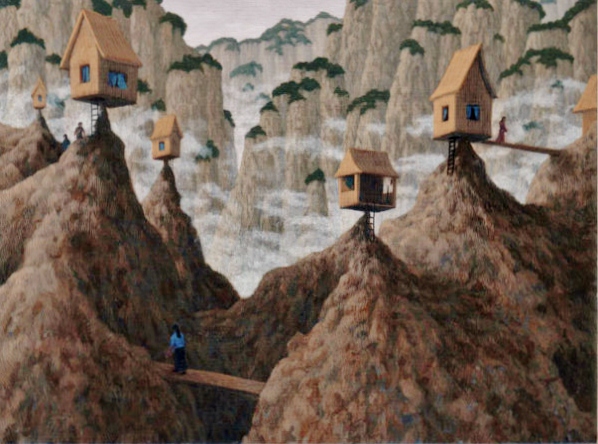Invisible Cities
NPR’s sites use cookies, similar tracking and storage technologies, and information about the device you use to access our sites (together, “cookies”) to enhance your viewing, listening and user experience, personalize content, personalize messages from NPR’s sponsors, provide social media features, and analyze NPR’s traffic. This information is shared with social media, sponsorship, analytics, and other vendors or service providers. See details.
Ancient Invisible Cities The Acropolis in Virtual Reality. Darius Arya explores one of Ancient Athens’ most important sacred temples in VR. Clip: S1 1m 22s. Invisible Cities is a novel by Italian author Italo Calvino, published in 1972. Major themes of this work are imagination and perception, truth and deception, and the inevitable passage of time. Invisible Cities, set in LA’s historic Union Station, allowed the audience to roam freely through an operating train station, pursuing individual characters or creating their own story. The audience experienced the live performance via Sennheiser wireless headphones surrounded by the uninterrupted life of the station. We at Diskotopia are incredibly excited to be presenting the new album Invisible Cities from Memotone, the principal alias for Bristol-based multi-instrumentalist, composer, and producer William Yates. From Invisible Cities: In Olinda, if you go out with a magnifying glass and hunt carefully, you may find somewhere a point no bigger than the head of a pin which, if you look at it slightly enlarged, reveals within itself the roofs, the antennas, the skylights, the gardens, the pools, the streamers across the streets, the kiosks in the squeares.
You may click on “Your Choices” below to learn about and use cookie management tools to limit use of cookies when you visit NPR’s sites. You can adjust your cookie choices in those tools at any time. If you click “Agree and Continue” below, you acknowledge that your cookie choices in those tools will be respected and that you otherwise agree to the use of cookies on NPR’s sites.
April 18–May 20, 2017
Invisible Cities is an exhibition divided into three parts—organized into three 'cities.' The show borrows its title from the eponymous 1972 novel by Italo Calvino. Calvino's novel is less a story, an imaginative travelogue, than an investigation into the human condition. Like Calvino's text, the exhibition Invisible Cities touches on disparate themes and differing infrastructures, mediated systems, the parafictional, and the digital baroque, to describe the multiplicities of contemporary subjectivity. The show takes viewers on a journey through a trio of complementary media–the photographic, the filmic, and the digital—as it examines the complicated relationship between representation and mediation.

The exhibition is curated by Page Benkowski, Taylor Fisch, and Georgia Horn, each a graduate student in the Modern Art: Critical and Curatorial Studies program in the Department of Art History and Archaeology. Organized in three sections, works in this exhibition operate within a frame, whether the lens of a camera or a computer screen. These technological intermediaries challenge the conventions of looking by calling attention to their mechanisms of reproduction. The sections curated by Benkowski and Horn each engage a contemporary culture that dwells comfortably in the liminal space between the real, the hyperreal, and the 'para-real.' Meanwhile, Fisch questions how objects retain histories and the role images play in the construction of narratives.

Benkowski's contribution, #digitalbaroque, presents works by Anthony Antonellis, Cameron Askin, Carla Gannis, Joe Hamilton, Jillian Mayer and Lucas Leyva, Lorna Mills, Allison Parrish, and Katie Rose Pipkin. These artists all engage with the dynamic, participatory aesthetic of the digital baroque, creating artworks sited in the fold between the physical and the cyber that invite—and sometimes even demand—viewer-participation to be fully-realized.


Horn's project, A Slow Drift, features three films and a sculpture by Rosa Barba. Suspended between dichotomies—permanent and impermanent, real and fictional, obsolescent and modern—her works express both a concern for and an interest in the human interaction with landscape and geology. Each piece questions the relationship between memory and cinema, how memory is constructed, how tradition is preserved, and how filmic narrative is constructed in, around, and beyond reality.
Lastly, Fisch's section, The Still Life as Political Object, examines contemporary artists engaging conceptually and photographically with the still life tradition. Presenting works by Petros Efstathiadis, Roe Ethridge, Shadi Ghadirian, Leslie Hewitt, Annette Kelm, Rashaad Newsome, Jean-Luc Moulène, Indrė Šerpytytė, Taryn Simon and Christopher Williams, Fisch evaluates the genre's imaging of material culture as intrinsically bound to global political, social, and economic networks.
Invisible Cities Calvino Pdf
As Calvino wrote in his novel, 'With cities, it is as with dreams. … Everything imaginable can be dreamed, but even the most unexpected dream is a rebus that conceals a desire or, its reverse, a fear. Cities, like dreams, are made of desires and fears, even if the thread of their discourse is secret, their rules are absurd, their perspectives deceitful, and everything conceals something else.' Invisible Cities lays bare the imagined dreams, the hidden anxieties, and the real desires of contemporary culture.